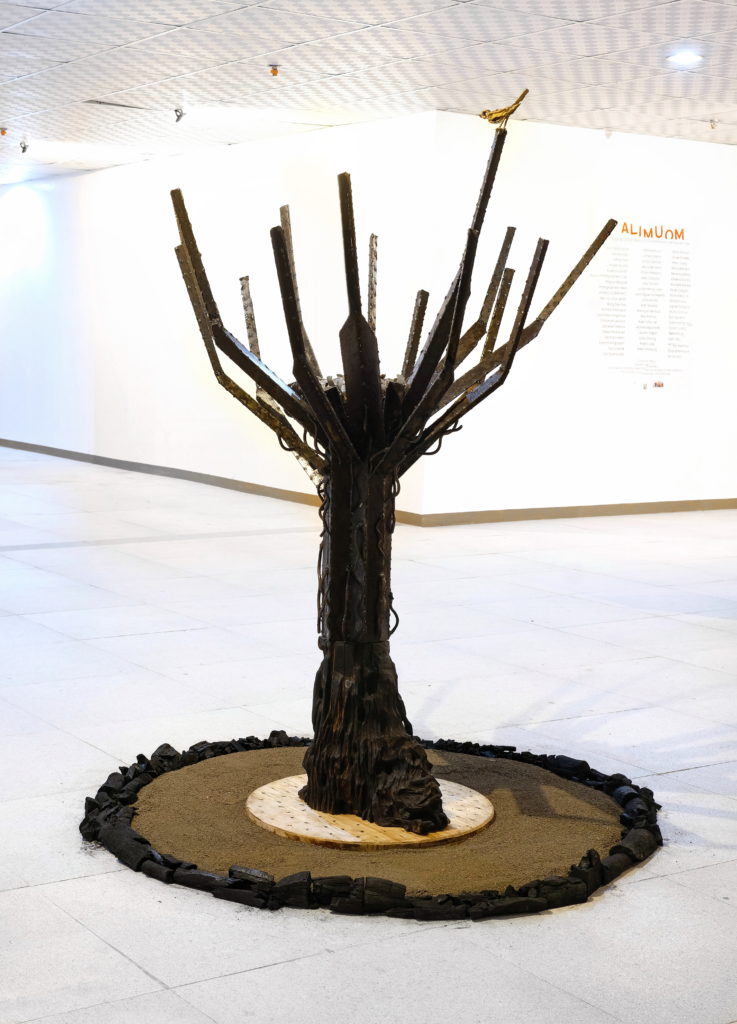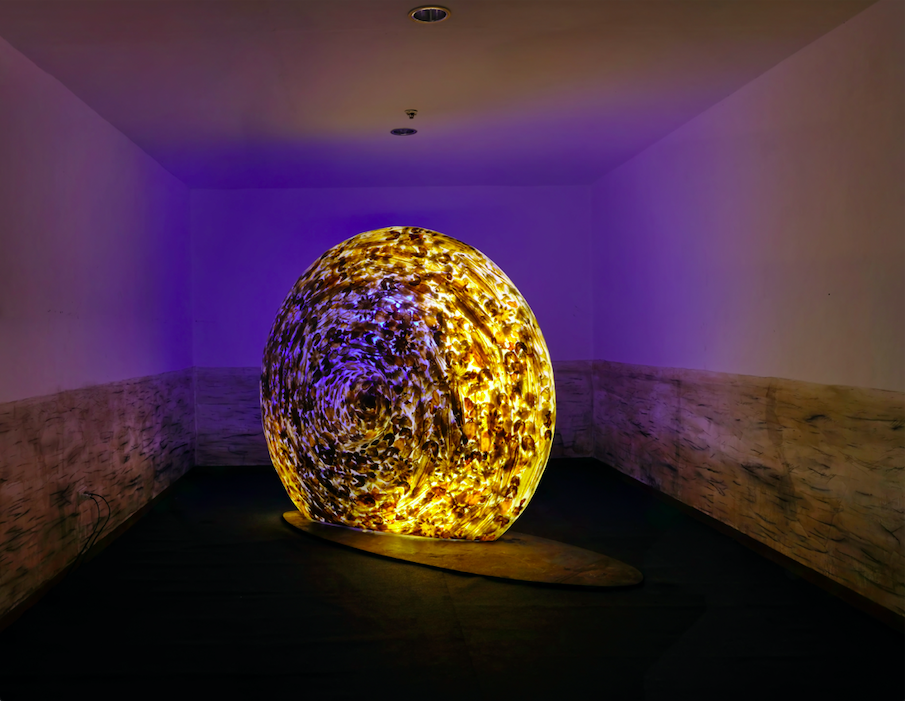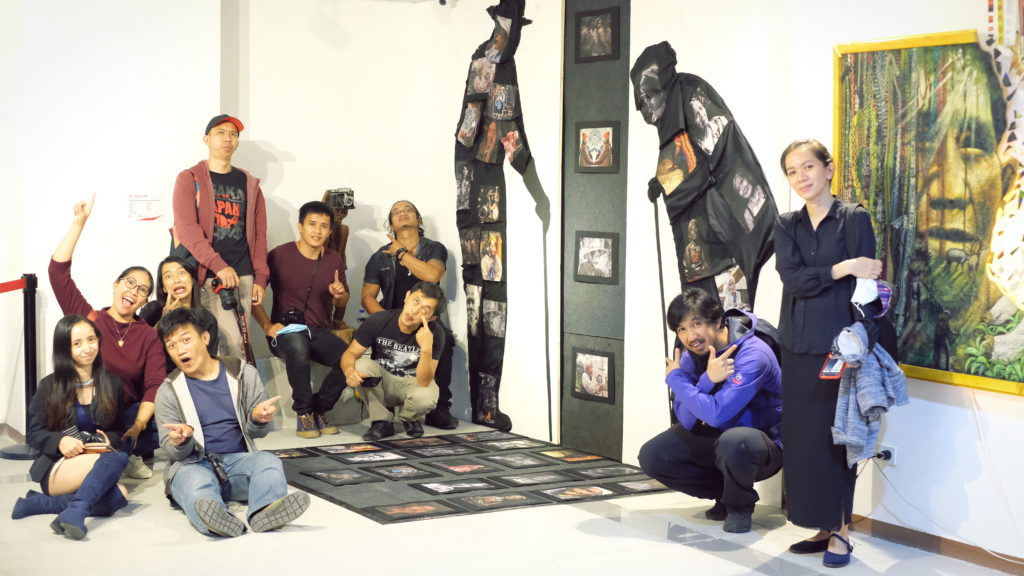by Amirahvelda Priyono
Rencontre avec Fara Manuel-Nolasco, commissaire d’Alimuom Ibagiw 2021
Alimuom est un mot d’origine Philippine et dont la signification prend trois sens différents. Tout d’abord, il s’agit d’une odeur s’apparentant à la terre mouillée par la pluie lors d’un long été chaud. Alimuom décrit également un sentiment romantique, une certaine douceur rappelant la nostalgie que peut évoquer la pluie. Ce terme est aussi utilisé pour qualifier les maux d’estomac lorsque, lors de conflits, les parents défendent leurs enfants de rester dehors. Ces trois significations sont devenues une source d’inspiration pour la réalisation d’une exposition dans la ville froide et montagneuse de Baguio. A quatre heures de Manille, Baguio possède une place particulière dans le cœur des Philippins. Il s’agit d’une destination prisée pour son climat rafraîchissant où, pour quelques jours, les visiteurs se relaxent ou oublient le tohu-bohu et l’agitation des grandes villes. C’est pour cela que Baguio est exceptionnelle aux yeux de tous. Cette spécificité inspire tout particulièrement la production artistique contemporaine. Ainsi, le caractère unique du lieu a fait naître l’idée d’exposer l’évènement Alimuom Ibagiw 2021 au sein du Baguio Convention Center (BCC). L’exposition est à la fois accessible sur place et en ligne à travers le site internet.

Baguio City : Une ville symbole de nostalgie
“Le thème est lié au lieu et au contexte qui occupent une importance significative, et il contribue à façonner le sens de notre travail.” Fara Manuel-Nolasco
Fara Manuel-Nolasco, qui est la commissaire en chef de l’exposition Alimuom Ibagiw 2021 et aussi professeure adjointe à l’Université des Philippines, explique le caractère hybride grandissant de la ville. Différentes populations, groupes et tribus indigènes coexistent. Leur nombre croissant impacte l’urbanisation de Baguio. C’est ce changement et la transformation de la ville qui inspirent le travail des artistes.
Alimuom étant le thème de l’exposition, les trois questions suivantes émergent. Quel est le sens de la terre natale pour les artistes ? Quels sont les lieux qui leur sont chers ? De quelle manière perçoivent-ils l’environnement aujourd’hui ?
L’importance de ce sujet réside dans le fait d’évoquer des moments vécus ou de partager les souvenirs nostalgiques de ceux qui connaissent Baguio depuis leur enfance. C’est pour cela que l’événement semble porter sur le développement galopant de la ville et son caractère hybride. Baguio joue depuis les années 1980 un rôle dans le milieu artistique contemporain par la mise en place d’espaces d’expositions emplis de dynamisme où l’artiste est libre d‘exploiter sa créativité. Cela a permis à des pratiques artistiques contemporaines comme les installations, la performance, les arts sonores et littéraires de se développer librement et d’être acceptés. Si le Baguio Convention Center n’appartient plus aujourd’hui au gouvernement, Fara assure que le BCC restera un lieu d’épanouissement pour les arts.
Les artistes Philippins et leurs arts
Collaborant et exposant plus de 57 artistes, dont quatre collectifs, activistes, artistes professionnels et étudiants en arts, Fara a mis en avant dix artistes Philippins, selon la matière et le thème employé dans leurs œuvres, en commençant par Nona Garcia. Celle-ci a installé une vidéo monocanal intitulée “Comme le flux d’une vague brisée, à ceux qui ont entendu la mer” et portant sur la cordillère et des artefacts indigènes, des reliquaires, ou de délicats os d’animaux esquissant la forme de mandala. Son travail s’apparente aux radiographies. Ainsi, les visiteurs découvrent les ossements et divers objets rendus visibles par une lumière bleue, luminescente, dans laquelle ils sont baignés et leur conférant une apparence mystérieuse.
Leaonard Aguinaldo présente Les Histoire de Baguio, une imposante gravure sur bois imprimée sur papier. Il ressuscite 100 ans après la Aringay-Baguio Line 10, qui fut un chemin de fer construit par le gouvernement colonial américain. Ce lieu comportait un marché qui ouvrait chaque weekend et où les Igorots devaient porter leurs costumes rituels. Les Ilocanos arboraient le plus blanc de leur pantalon en peau de requin, même s’ils n’étaient présents que pour vendre des chiens, du sel ou du tabac. Cette œuvre montre comment le gouvernement de Baguio tenta d’entreprendre la transformation du marché de la ville en un grand complexe commercial. C’est durant le confinement dû à la pandémie causée par le COVID-19 que l’artiste en eut l’idée.

L’artiste suivant est Kawayan de Guia, d’origine Philippine il travaille différent médium comme l’installation, la peinture et la sculpture à travers un mélange éclectique d’objets au sources variées. Son travail évoque principalement les problèmes liés à l’occupation, au commerce et aux échanges qui ont influencé la culture Philippine, son histoire, ses communautés et marchandises.
Beaucoup d’artistes de renoms ont participé à cette exposition comme Bumbo Villanueva, Rene Aquitania, Rocky Cajigan, Auspicious Family, etc….
Le défi de la pandémie
Le Covid-19 persistant, accueillir les œuvres et les visiteurs est un véritable challenge. Cependant, dès le premier jour, Fara et son équipe ont su maîtriser la situation avec brio, de la collecte des œuvres chez les artistes, à la direction de leur installation dans l’espace d’exposition ou à leur mise en ligne. Installer l’exposition en engageant un groupe de cinq personnes dont le commissaire en chef, fut plus que suffisant.
Les défis concernant Fara, en tant que commissaire d’exposition, réside dans la manière d’appréhender les attentes du public. Elle pense que les visiteurs souhaitent avoir à disposition une approche accessible, voire “facile” de l’œuvre d’art. Cependant, cette fois-ci, avec son équipe, elle a tenté d’amener le spectateur à remettre en question sa vision même de l’art. Dans ce cas précis, donner davantage d’informations, de contexte, peut permettre de déclencher chez la personne certaines émotions et souvenirs, beaux ou agréables. Au lieu de partager quelque chose de trop facile à percevoir, à lire, il est temps pour le public de découvrir la manière dont il regarde une œuvre.

Meeting with Fara Manuel-Nolasco, curator of Alimuom Ibagiw 2021
Alimuom is a Filipino word with three different meanings. First, it symbolizes something that everyone can smell from the ground when there is a gentle rain after a long and hot summer. Moreover, Alimuom has a romantic and sweet sense that is linked to the feeling of nostalgia when people see rain.
However, it can also mean the stomach ache caused by parents and elders in the Philippines when they warn children from staying out during battle. All of these significations have inspired the making of an exhibition in the cold and mountainous city of Baguio. Located 4-hours away from Manila, it holds a very special place in the hearts of every Filipino. It is a popular destination for its refreshing climate where, for a few days, visitors can relax or forget the hustle bustle of the big cities. This is why Baguio is so exceptional in the eyes of all.
This very fact has inspired contemporary artwork. The uniqueness of the place has birthed the idea of showcasing Alimuom Ibagiw 2021 at the Baguio Convention Center (BCC), in Baguio City. It is accessible both onsite and online through the website.
Baguio City : A city that brings nostalgia to Everyone
“The theme is linked to a place and a context that are holding a significant importance and it contributes to shape the meaning of our work”. Fara Manuel-Nolasco
Fara Manuel-Nolasco, the head curator of Alimuom Ibagiw 2021 and also an assistant professor at the University of Philippines, explained that Baguio City has gotten more “hybrid” as time goes by. Different populations, groups and indigenous tribes coexist. Their growing number progressively affects the city’s urbanization. It is this transformation of Baguio that inspires artists.
Alimuom being the theme, we can ask three questions. What is the meaning of “home” for artists? What are the places they are caring for? How do they view the environment now?
The importance of the theme resides in the action of evoking the past or the nostalgia of people who have known Baguio since their childhood. It is why this event is about the accelerating development of the city and it’s new hybrid nature. Baguio has had an important role in Filipino contemporary art since the 1980’s thanks to the creation of dynamic exhibit spaces where artists were free to create. It was a way for many artistic practices like installation, performance, sound and literature to develop and to be acknowledged. Even though the venue doesn’t belong any longer to the government, Fara added that BCC will always be a place for the art to thrive.

Filipino Artists and Their Works
Working and exhibiting the work of 57 artists, including four collectives, activists, professional artists and art students, Fara highlighted ten Filipino artists based on the material and topics chosen, starting with Nona Garcia. She installed a single-channel video called “ Like the ebb of a broken wave to those who have heard the sea” that focuses on Cordilleran and indigenous artifacts, reliquaries of saints or animal bones shaping a mandala. Her work recalls X-Ray. So, the public can discover bones and objects made visible thanks to a blue and luminescent light, in which they are bathed and which is giving the artwork a mysterious atmosphere.
Leonard Aguinaldo showcased The Baguio Stories, an imposant woodcut then printed on paper. He has revived 100 years after Aringay-Baguio, a railroad built by the American colonial government. A market that opened every week-end could be found in this area and where the Igorot population were required to wear their ritual costumes. The Ilocanos would have to be dressed in their whitest sharkskin trousers even if they were only there to sell dogs, salt and tobacco. The artwork shows how the Baguio government seemed to railroad the takeover of the Baguio City Market to a big mall complex. It is during lockdown, due to Covid-19, that the artist came up with this very idea.
The next artist is Kawayan de Guia, a Filipino artist who works on installation, painting, and sculpture through an eclectic mix of artifacts from various sources. His work mostly focuses on problems linked to occupation, trade and exchange which influenced the Philippines culture, its history, communities and commodities.
Many well-known artists took part in this exhibition such as Bumbo Villanueva, Rene Aquitania, Rocky Cajigan, Auspicious Family, etc…

Challenge in the middle of the pandemic
As the Covid-19 is still persistent, welcoming artworks and visitors has been a tough challenge. However, from day one, Fara and her team were able to master the situation brilliantly, from collecting the works from the artists, to directing their installation in the exhibition space or putting them online. Installing the exhibition by hiring a group of five people, including the chief curator, was more than enough.
Fara’s challenge, as a curator, holds in the way of understanding the audience’s expectations. She believes that the public wants an accessible and easy approach to the work of art. This time, with her team, she tried to challenge the audience about their own vision of what can be considered as art. In this precise case, giving more contextual material can be helpful to trigger beautiful or pleasant emotions and memories for the visitor. Rather than sharing something too literal or easy to perceive, it is time to explore how they see an artwork.


1 commentaire
Les commentaires sont fermés.